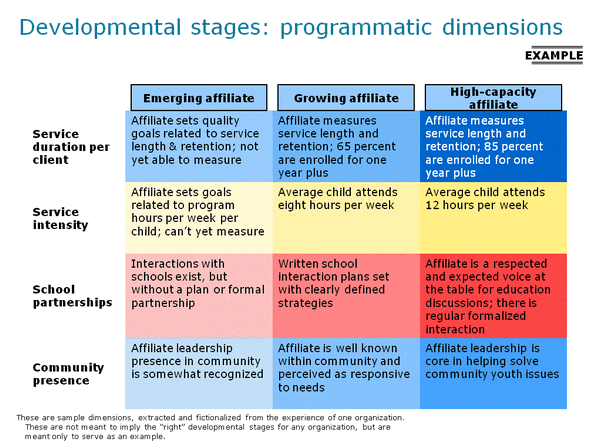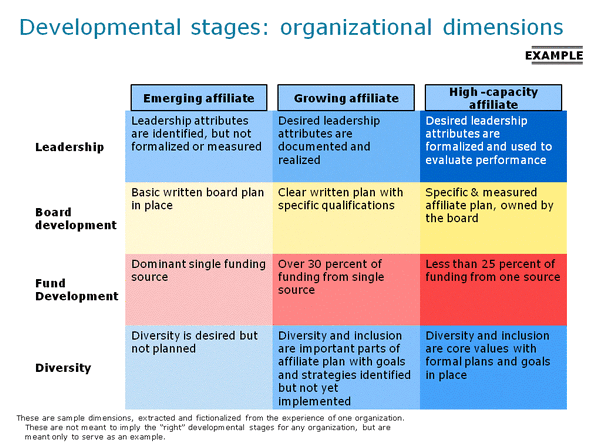Next In: Preparing to Grow Your Network's Impact
-
Start with Strategy: Use the network’s unified strategy to drive decision making
-
Create Paths: Create paths for improvement for affiliates
-
Diagnose Performance: Diagnose where the network is today and uncover pockets of strength
-
Facilitate Learning: Use diagnostic results to facilitate learning and improvement
Overview
What is the developmental path for affiliates?
When the entire network knows what it means to be effective, it will be easier to identify the developmental stages that lead to that goal and set milestones to encourage and enable progress. It’s likely that you’ll find some real range across the network; some affiliates may be much further along in terms of performance than others. Once you identify a few key stages of development, though, individual affiliates will be able to use them to evaluate their own relative strengths and weaknesses. Keeping a developmental rather than punitive mindset is critical to this step – the goal of defining developmental stages is not to punish organizations that fall outside a certain band, but rather to give clear indicators of development needs.
There are two parts to this element:
- First, clarify stages of development for each individual dimension that has been selected. Plan to factor in both an objective viewpoint of what defines effectiveness and a sense of the current range of performance against a given dimension. This will lay the groundwork for affiliates to assess themselves against the dimensions.
- Second, determine higher level groupings for the overall developmental stages of affiliates. (We reference these as “affiliate stage groups.”) If affiliates were to be grouped into three or four general categories based on their overall developmental stage, how would you determine whom to group together? This will lay the groundwork for affiliates to identify peer organizations that are at a similar stage, and to inform the center’s approach to tailoring supports to affiliates.
(We have found the terms “emerging,” “growing” and “high capacity” to be useful constructs for development stages, but these terms aren’t set in stone; select the terms that mean the most for your network.)
Part 1: Determine developmental stages for each dimension
Related Content
Wherever possible, you’ll want to use historical data and existing performance data to inform the creation of developmental stages. You may want to chart whatever performance data you have for each dimension to see if any clear clusters of distribution emerge. In the following illustrative example, an after-school provider network identifies three clear clusters of affiliates based on success with keeping students on track to graduate after one year of work with those students.
Download a PowerPoint copy of "Programmatic Dimension Groups."
Ideally, your network should aim for the same number of stages across all dimensions – three or four is most common. Within each dimension, it is helpful to set a “reach” target for improvement. For example, your network could decide that no more than 30 percent of current affiliates should start off in the highest-capacity group. You will likely find that you revise these stages as you iterate between the different elements in this process. You may also know for a fact that a group of affiliates is not yet able to measure a given dimension; if that group is the majority, more work might be needed for the dimension to be relevant for your five elements process. If only a minority of affiliates do not have the capacity to measure a given dimension, they might become the emerging group—at least on that dimension.This link will take you to an illustrative example of an after-school provider network’s set of developmental stages for both programmatic and organizational dimensions. [2]
2.gif)
Download a PowerPoint copy of "Developmental stages: programmatic dimensions."
2.gif)
Download a PowerPoint copy of "Developmental stages: organizational dimensions."
Every affiliate has relative strengths, and opportunities to improve. Using affirmative words to describe stages will increase the likelihood that affiliates will face the challenges associated with this process, and persevere.
Part 2: Determine overall affiliate stage groups
Once you have determined developmental stages for each dimension, it’s time to develop overall definitions for “affiliate stage groups.” As a reminder, the ultimate purpose of developing these overall groups is to help affiliates connect with others at a similar overall developmental stage, and to help the center assess how it can meaningfully tailor supports to groups of affiliates.
There are multiple ways to go about determining group boundaries. Common approaches include:
- Aiming for four overall groupings, with roughly the following breakdown:
- High capacity on both programmatic and organizational dimensions
- High capacity on programmatic dimensions, but low on organizational
- High capacity on organizational dimensions, but low on programmatic
- Low capacity on both programmatic and organizational dimensions
- Looking across all dimensions and grouping affiliates into 3-4 categories based on one or two dimensions that are seen as ultimately the most important, and most indicative of an affiliate’s progress.
Following is an example of the matrix your network could use for approach 1.
Download a PowerPoint copy of "Sample affiliate stage groups."
In reality, setting the boundaries for these groups will be a mix of art and science, depending on how neatly affiliates fit into specific patterns. You may determine, for example, that an affiliate must be in the growing group or higher on every dimension—and in the high-capacity group for at least half—to be in an overall high-capacity group. Or you may take more of an average. Just keep in mind that the choices you make here should inform the supports that the network eventually will need to provide for affiliates.
Case Study: Public Education Network
The Public Education Network (PEN), an associated network of Local Education Funds (LEFs) provides a prime example. LEFs provide support and advocacy for public education; as PEN’s mission states, the network’s leaders and members work together to “build public demand and mobilize resources for quality public education for all children.” In 2009, PEN’s leadership developed a strategy that included building a stronger network and defining more clearly what it meant to be an LEF. Read more >>


